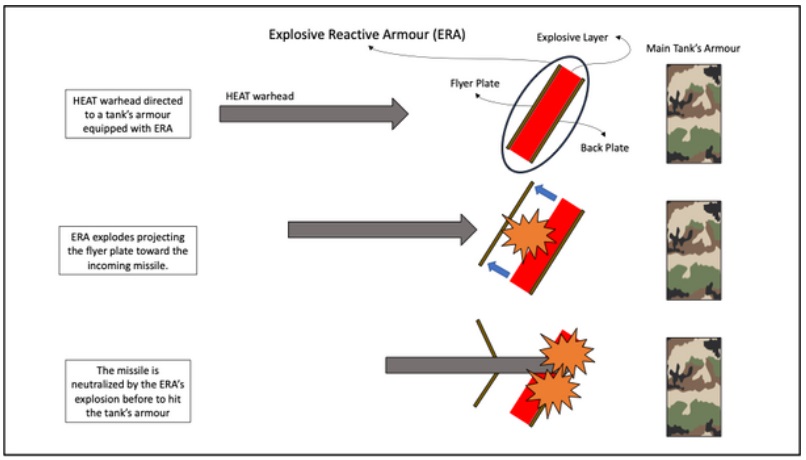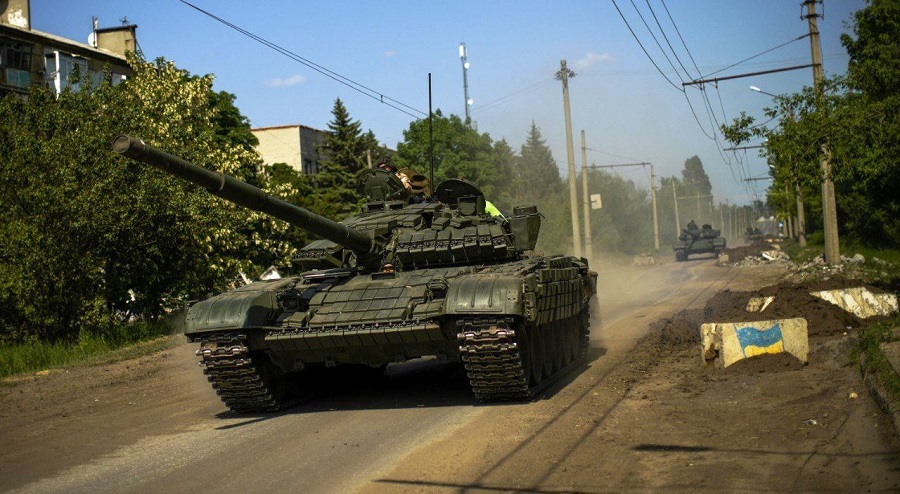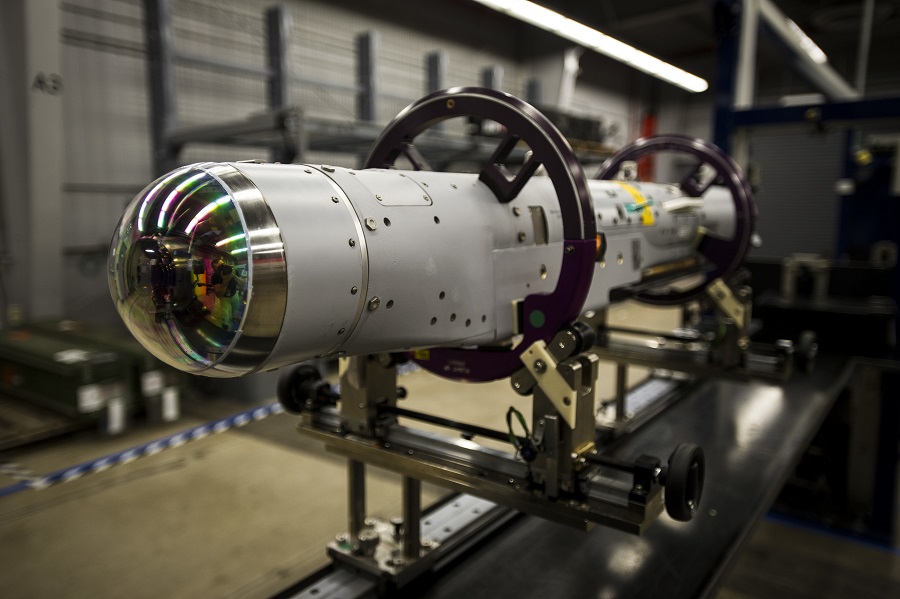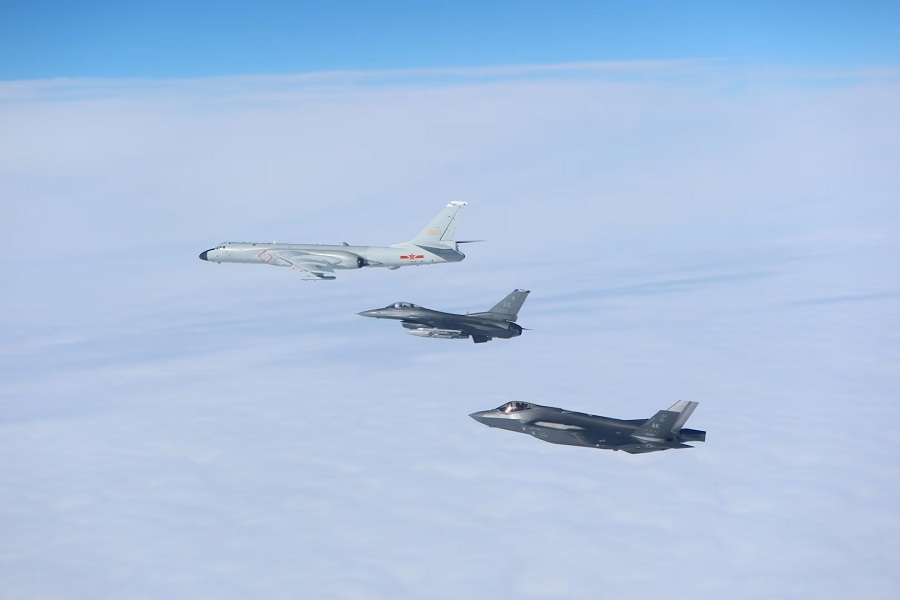Introduction
With the live coverage of the war in Ukraine from media all around the world, it is easy to run into photos or videos of Russian tanks. In Ukraine, Russia’s main battle tank (MBT) is the T-72, but they also deployed some T-80s and some T-90s. By carefully looking at these units, it can be noticed that Russian, but also Ukrainian tanks are equipped with small blocks all around their armour. These blocks are an additional defensive armour, which serves the purpose to protect the tank and its crew from anti-tank weapons. This additional armour is called Explosive Reactive Armour (ERA) and was first introduced on an Israeli tank in the 1982, during the war in Lebanon. From that moment on, almost every main battle tank of the most powerful armies in the world would have equipped it. However, the ERA brought with it a little revolution in tank and anti-tank warfare since it pushed engineers and mechanics to start, research and develop new weapons to penetrate the ERA and destroy the tank. In this paper, the main historical events, and the evolution of this defensive equipment are analysed. Moreover, the actual application of ERA will be studied, its developments, the new projects and more broadly how it changed tank and anti-tank warfare.
The History of ERA
In 1949, in the Soviet Union, a Ukrainian scientist called Bogdan Vjacheslavovich Voitsekhovsky, elaborated for the first time in history the idea of triggering a directional explosion to protect an armoured vehicle to be destroyed. This idea of counterexplosion was proposed through the Scientific Research Institute of Steel to the Soviet Armed Forces. However, during the first practical experiment, the scientists miscalculated the quantity of explosive to put on the armour and it caused the destruction of the tank. This result led Soviet leaders to abandon the idea of an explosive defensive armour, instead of developing and improving it. However, the idea returned actual in the military research in the 1970s, when a Norwegian scientist, Manfred Held, registered a patent in West Germany for a Reactive Armour (RA) in 1970. Israeli authorities saw the potential advantage that such a technology would have given them and offered Held to work with the Israelian Rafael Armament Development Authority to develop the RA. The result was the “Blazer” RA, that was first applied to Israeli tanks in 1982, in the Lebanon War. When the world saw the improvements that the RA gave to Israeli tanks, also the two superpowers started to work on it. The Soviet Union applied their first RA in 1983, and the US first used it in Operation Desert Storm in 1991, on M-60 tanks. Nowadays, several evolutions of the first RA can be seen on the battlefields, giving an extra-protection to the main battle tanks of almost every armed force in the world.
Composition and Features of ERA

One of the main features of the ERA system, is that it is extremely efficient against shaped-charged jets, even if the total weight of the ERA would not compromise the manoeuvrability of the tank. The MSM Group, one of the main industries in the field of ammunition in Europe, estimated that the total amount of ERA’s weight is around 2700 Kg on a T-72 M1 tank (MSM Group, accessed on 21 September 2022). If it is considered that the total weight of the T-72 is around 41’000, then it can be said that ERA would not influence the tank’s tonnage to a great extent.
Another important feature is that it is possible to change the inclination of each ERA’s block. In fact, as several mechanical and physical studies demonstrated, if on one hand the detonation delay has effects on ERA’s efficiency, on the other hand, also both the NATO angle (1 NATO = 0,056 degree) in which a block of ERA is positioned on the tank, and the missile’s point of impact on an ERA’s block will contribute to increase or decrease its effectiveness. About the detonation delay, it is possible to say that it can influence the deformation of the projectile when this hits ERA. Studies and experiments conducted on the interaction between ERA and tungsten long-rod projectiles, showed that ERA is most effective when the detonation happens in an interval of time comprised within 150 and 200 ms before the projectile hits the block. This result is obtained because the detonation gives enough time for the flyer plate to increase the penetration path of the projectile. Regarding the NATO angle positioning, it was shown that the optimum NATO angle is that of 60 degrees, in which the reduction in penetration is 84,54% practically and 75% (by simulation)’. In addition, concerning the point of impact, a simulation conducted by the Egyptian Armed Forces in the 21st International Symposium of Ballistics revealed that, whereas ERA is most efficient when the missile hits the bottom part of the block, it is less efficient when hits in the centre, and the least efficient point of impact is the top of the block. These parameters allow us to conclude that an ERA system works perfectly when it is hit in the bottom part of the block with a 60° NATO inclination. Another parameter that can affect the effectiveness of the ERA is the stand-off distance between the blocks and the tank’s main armour. However, this parameter has little effect, if confronted with the first three.
Evolution of ERA and Its Impact on Anti-Tank Warfare
Since from its first appearance on the battlefields, ERA has also been employed in urban environments; with tanks that operate along with infantry, this system caused problems in combined arms operations. In fact, in urban environments, it is not possible for the infantry to operate distant from tanks. The narrow distances causes a lot of losses and wounds to the infantry troops that found themselves near to the explosion of ERA. Indeed, ERA’s explosion, in addition to the detonation of the missile targeting the tank, increases the explosion radius, endangering the troops. This situation led scientists and mechanics to start research to find a solution to the collateral damages problem. One solution is the Non-Explosive Reactive Armour (NERA), also known as Non-Electric Reactive Armour (NxRA) depending on the vehicle and the country that employs it. These new Reactive Armours (RA) can work both on MBT and on heavy infantry vehicles. NERA is based on the same principle of ERA, but it does not present the explosive layer in the block, which is replaced by different layers of several materials, including elastic material, that can absorb the projectile’s shock wave. The result of the hit is the bending of the NERA block, which neutralizes the projectile, diverting its trajectory and increasing penetration space. Since NERA does not create an additional explosion, it is safer for nearby infantry troops, however, it registered slightly fewer percentages of effectiveness.
Nonetheless, many armed forces around the world choose NERA systems for their tanks, since they are less expensive, and less heavy than ERA’s actual models. Another advantage of NERA is that it can resist against tandem warhead shaped jets. These types of warheads were planned and developed by the US Army specifically to neutralize Soviet tanks ERA’s effect. A tandem warhead is basically a conventional warhead with two shaped charges, one less powerful in front of a more powerful one. When a tandem warhead hits an ERA box, the first shaped charge triggers ERA’s detonation, to allow the second charge to successfully penetrate the tank’s armour, destroying it. Nowadays, tandem warheads are commonly employed on RPG-27 and RPG-29, as well as on the Franco-Germans MILAN and HOT missiles. In addition, well-known FGM-148 anti-tank missiles, commonly known as Javelin, employ HEAT missiles with a tandem-warhead. To overcome the challenge imposed by these warheads, tanks can employ NERA systems or the second-generation ERA. With regards to NERA, it can be effective against tandem warheads, however its efficiency will slightly decrease after the first hit, and it can be vulnerable to further attacks. As far as the focus is shifted to the second-generation ERA, it is possible to say that they are highly effective against tandem warheads, but they are very heavy and do not overcome the problem relating to proximity with infantry troops. In fact, these new ERA systems are essentially two surmounted blocks of ERA, which detonate in a double time interval to neutralize both the shaped charges of the tandem warhead. The latest evolution regarding reactive armours is the Electric Armour for Armoured Vehicles (ELAV). This type of reactive armour is not yet employed by any tank in the world except for prototypes. However, its functioning and its features are well known, thanks to academic studies, as well as reports and summaries commissioned by institutions, such as the European Defence Agency (EDA). The structure of an Electric Armour (EA) is the same as the ERA and NERA, with two plates that cover a middle layer. The difference for the EA is that the middle layer is filled with air, or some insulating material, that divides the two plates that serve as electrical conductors. When a projectile hits the first plate, it closes the electric circuit, causing an impressive electric discharge that will simply vaporize the projectile. A BMT Defence Services summary, commissioned by the EDA, reveals several advantages to EA, such as “reduced total system weight, wider applicability, enhanced performance against Shaped Charge, robustness to ballistic and Kinetic threats, multiple hit capability”. However, the EA also has some disadvantages, such as “minimum coverage area threshold for implementation, intermittent protection, significant vehicle power requirements”. In addition to these disadvantages there are also some applicability and research problems that are still impeding the employment of these armours on main battle tanks and other armoured vehicles.
Conclusion























